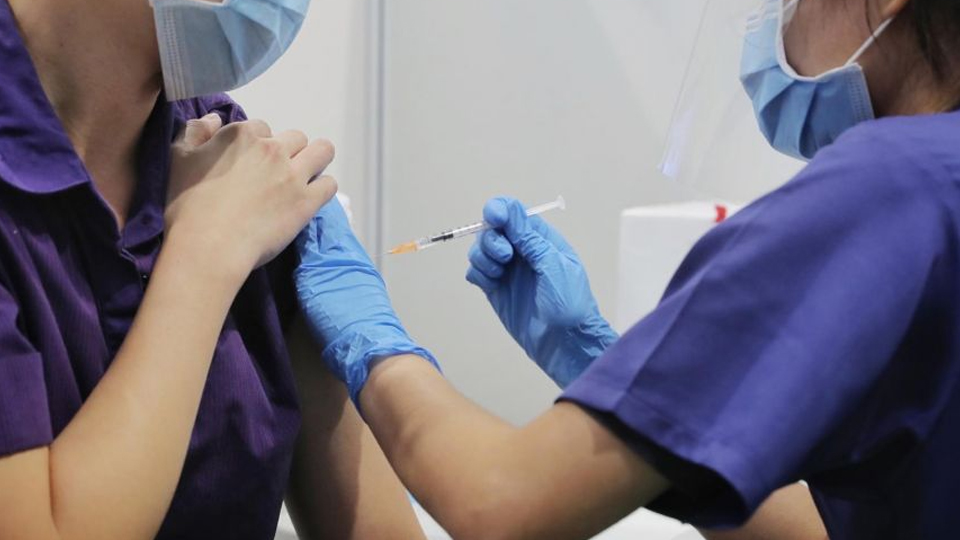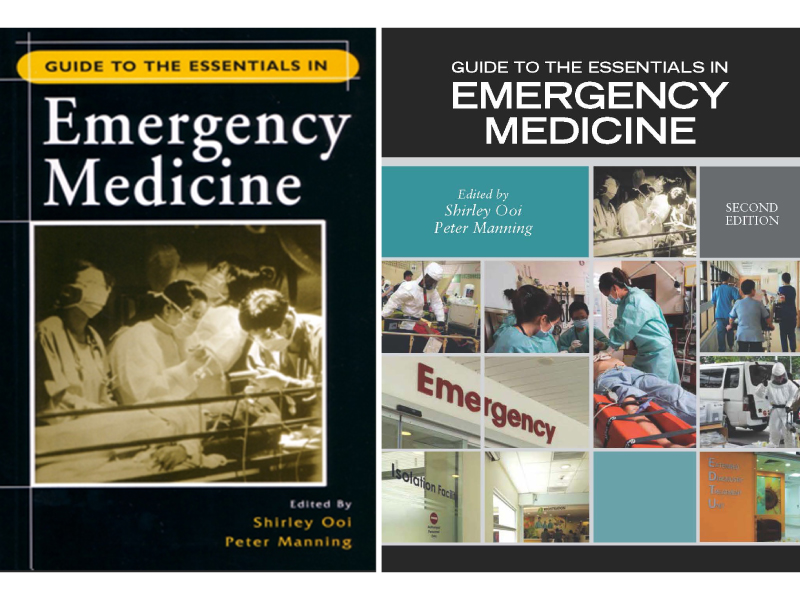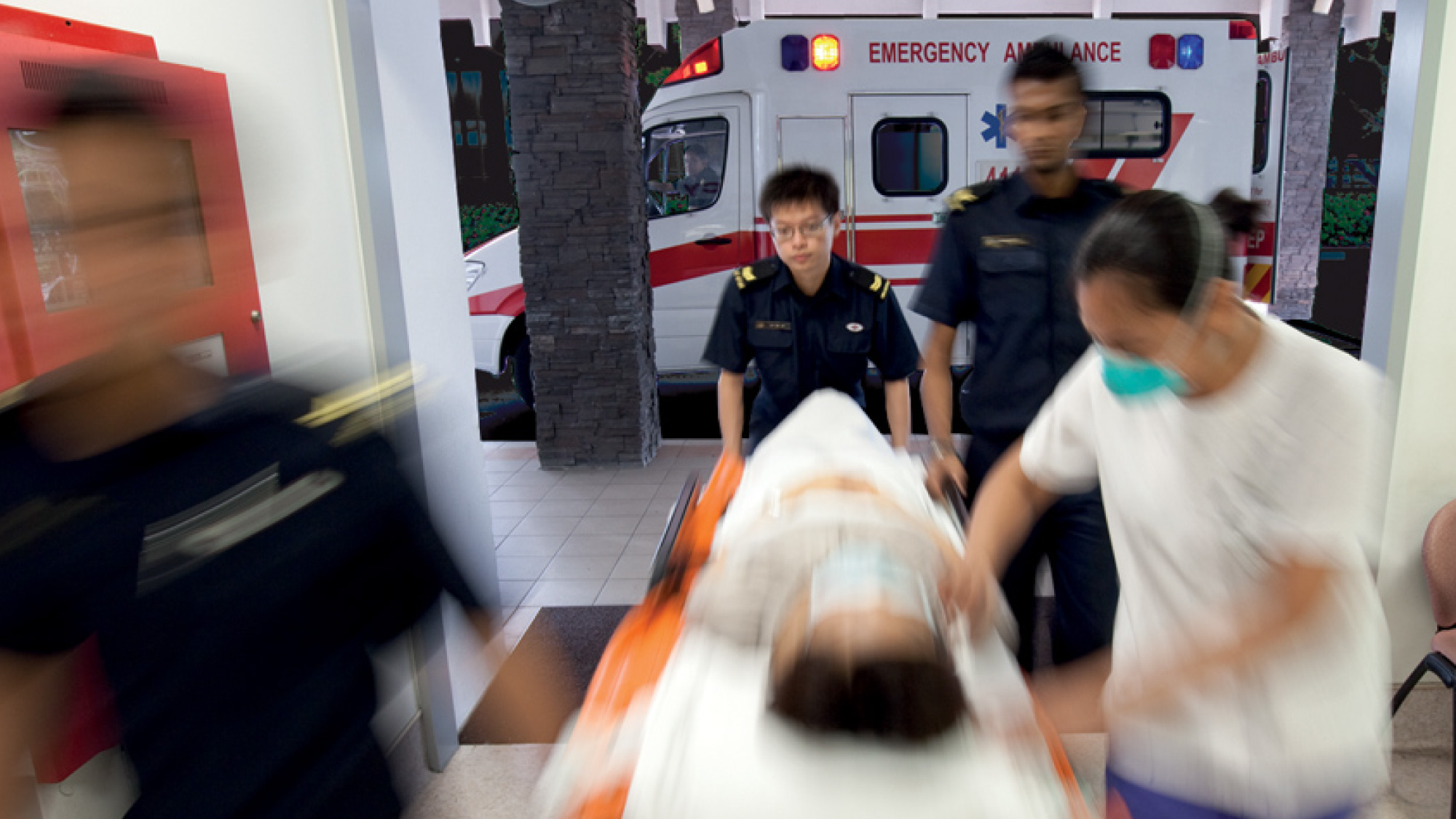NUS Dons Produce An International Bestseller

Associate Professors Peter Manning (left) and Shirley Ooi (right) at the NUH Emergency Medicine Department.
A textbook on Emergency Medicine techniques by two professors at the NUS Yong Loo Lin School of Medicine has become an international bestseller.
Titled ‘Guide to the Essentials in Emergency Medicine’, the textbook is the work of Drs Shirley Ooi and Peter Manning, both senior doctors at the NUH Emergency Medicine Department (EMD) and also associate professors at the NUS medical school. The Guide contains practical instructions that help emergency physicians tackle the most life-threatening and common conditions. Besides hospitals, the textbook is also used by general practitioners to diagnose and treat patients in their clinics, and medical students to learn about illnesses. The NUH is the primary teaching hospital of the School.
All the chapters in the book were put together by the two doctors and a team of NUH emergency physicians together with a few guest authors. The multi-disciplinary content includes practices and approaches adopted in various medical disciplines and applied under trauma conditions.
“Each chapter has got one, two, or even three authors and we would ask them for various redrafts. Then both of us would proof read and edit the chapters. But time is the issue, because all of us wear three hats – clinicians, teachers and administrators as well,” said Associate Professor Manning.
The first edition was released in 2004. It sold more than 15,000 copies and enjoyed multiple reprints. The second, current edition, which was released in 2014, has sold close to 10,000 copies so far, and reached the shores of countries such as Malaysia, Hong Kong, Japan, Taiwan, the United States, the United Kingdom and Australia.
The Guide’s popularity was a surprise to both doctors, who said they produced the textbook to help colleagues.
In the late 90s, Associate Professor Ooi noticed that the standard of care in the EMD at NUH was not uniform, with doctors adopting varying practices and approaches. She and Assoc Prof Manning felt a common or universal approach that was in keeping with the best practices in Emergency Medicine was important.
This also applied to staffing arrangements, added Assoc Prof Manning. “In the early days, there might have been shifts with just medical officers running the show,” he said.
Assoc Prof Ooi got the ball rolling, producing a list of common conditions. She then got her colleagues to pen down the best methods to treat them. After rounds of peer review, they circulated multiple copies of these guidelines in yellow and red files placed throughout the EMD.
“I found that it was quite popular, sometimes the whole file got missing, or portions of it. Or descriptions of conditions got missing. So because of that, around early 2000s, I thought maybe why not come up with a book?” she recalled.
Neither she nor Assoc Prof Manning expected the Guide to become a best seller and she was surprised to learn about its popularity during a medical conference in Malaysia, where some participants stopped her for a photograph and autograph.

1st (left) and 2nd (right) editions of the Emergency Medicine textbook.
She also recalled a remark by NUS Medicine Dean, Associate Professor Yeoh Khay Guan, who wrote the foreword for the second edition. “I remember when the book first came out and after it sold a significant number of copies, Khay Guan told me that no textbook written in Singapore had ever sold so many copies internationally other than Singapore math textbooks.”
While the book was produced to meet local needs, Dean Yeoh noted the relevance it held for international practice and patient care. “The high-quality instruction and practical information in this excellent text book will in turn lead to improved care of emergency patients all over the world,” he said.
On another occasion, an emergency physician practising in Indonesia told Assoc Prof Ooi that the techniques taught in the textbook had helped doctors to bring about a drop in maternal mortality numbers in hospitals in his province, a rate that is one of the lowest in Indonesia.
“I was glad that the information helped to save lives,” she said.
If the editors could improve on the textbook’s contents, it would be adding a section on the end-of-life care of patients. This is in face of the increasing number of ageing societies around the world.
“One area of Emergency Medicine that has really blossomed is end-of-life care. Ten years ago, nobody ever talked about that. Now, end-of-life issues will have to be quite a big section in the next edition,” Assoc Prof Manning said.
This section would reiterate current thinking on the subject, added Assoc Prof Ooi. “A lot of patients come in breathless, so we take measures like putting in that tube and committing them into an ICU bed. But now, we believe it’s more important for them to feel comfortable, so we give them morphine for example, then we bring them to a private room where the family members can be with them.”
EMD Sees Increase in Frail and Elderly Ill
Doctors at the NUH Emergency Medicine Department (EMD) are seeing more elderly sick.
Associate Professor Peter Manning, who is an emeritus consultant, said with Singaporean society ageing rapidly, more older people with multiple illnesses are seeking treatment at the EMD.
“So much more than 15-20 years ago. Nowadays, our patients in the 80s are so common, even 90s. Some are even centenarians,” added Assoc Prof Shirley Ooi, also a senior consultant at the EMD.
Common conditions include pneumonia, urinary tract infections and falls that result in hip fractures.
The severity and complexity of patients’ cases have also increased.
“A lot of patients have eight to 12 conditions. In the past, when we were practising years back, there were at most two to four conditions. But now it’s one whole long list,” said Assoc Prof Ooi.
To reduce “over users” from taking up resources at the emergency wards, Assoc Prof Manning believes there is a need to persuade people to turn to polyclinics and general practitioners for help instead of calling at trauma centres.
An extreme over-user his team sees a few times each week is a man who visits the EMD with complaints of “chest pain”. Despite a record of tests showing that he has no chest issues, the team has to attend to him whenever he comes.
“It depends on your philosophical attitude. Who should define the term ’emergency’? You should let the patient define whether it is an emergency or not. It’s easy for us after the event to say, ‘Well, that guy only had a little bit of a toothache, it wasn’t even an emergency. Why didn’t he take two Panadols at home and see the dentist?’ But until he presents himself, and you examine him, and find that he does not have a periapical abscess, only then can you say, he shouldn’t have been here.”

